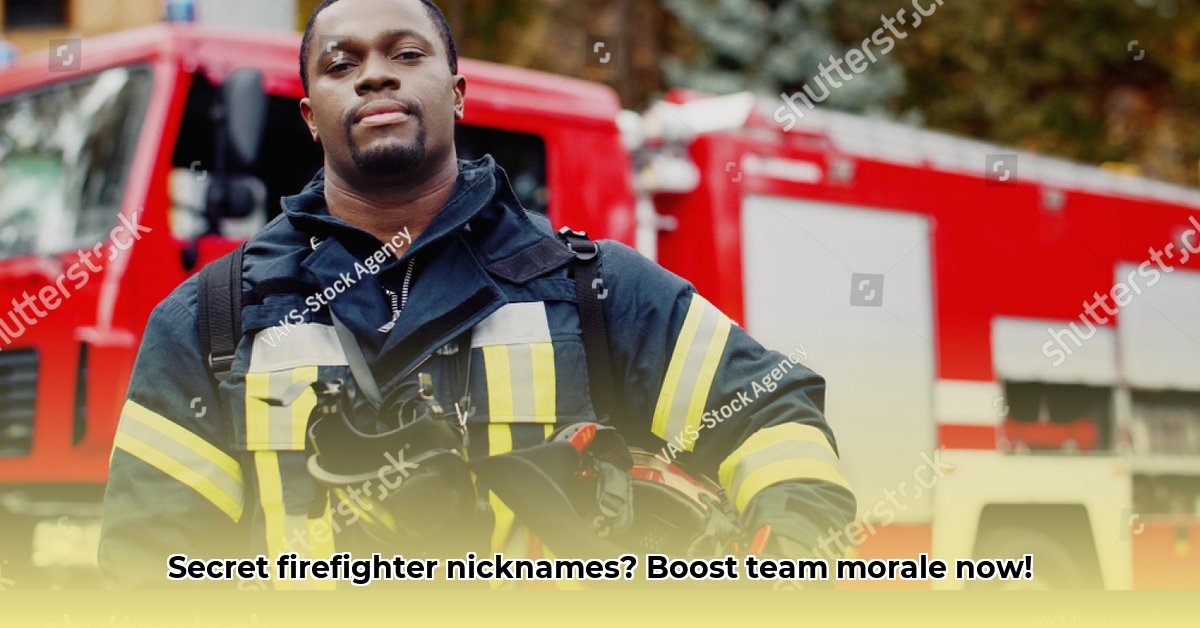Ever wonder about the specialized vocabulary of firefighters? This guide explores everything from official titles to informal nicknames and team names, revealing the importance of these names in team dynamics and community connection. You’ll discover how names impact teamwork, the origins of nicknames, and actionable tips for creating team names that build a strong, positive team spirit. Unlock the secrets to improving team communication and creating a supportive firehouse environment through effective use of firefighter nomenclature.
Firefighter Names: The Ultimate Guide to Boosting Team Morale
Firefighter names go beyond simple labels. They’re vital for building strong teams and connecting with the community. Understanding the nuances of formal titles, playful nicknames, and carefully chosen team names is critical to understanding fire service culture. Formal titles define roles, nicknames forge camaraderie, and team names create a shared identity. Together, they shape the heart of the fire service and its connection to the public. They also contribute significantly to the department’s public image, fostering trust within the community.
Firefighter Titles: More Than Just a Label
Formal titles represent structured hierarchies, ensuring efficient and safe operations during emergencies. Nicknames demonstrate trust and familiarity. Team names create a sense of shared identity and purpose. Each naming convention is a powerful way to build team unity. Think of the fire truck emblems and team names seen responding to emergencies. These titles aren’t just words on a badge; they represent a structured hierarchy key to coordinating action and saving lives. Consider how the strategic use of these names can influence team dynamics and public perception.
Formal Titles: The Official Roster
Formal titles are the backbone of a fire department’s structure, defining roles and responsibilities (who is responsible for what). During high-pressure situations, clear communication is vital, and these titles ensure everyone knows who’s in charge. The specific responsibilities can vary based on the size and structure of a specific fire department. These titles also carry a weight of respect and professionalism, influencing how firefighters interact with each other and the public.
| Rank | Typical Responsibilities |
|---|---|
| Firefighter | Entry-level; performs tasks under the supervision of senior personnel; often the first responders |
| Engineer/Driver | Operates and maintains fire apparatus; often leads the attack team during incidents; responsible for vehicle safety |
| Lieutenant | Supervises a company of firefighters; helps the Captain with incident command |
| Captain | Leads a fire company; responsible for the safety and effectiveness of their crew |
| Battalion Chief | Oversees multiple companies; may manage a larger incident or a specific geographic area |
| Assistant Chief | Assists the Fire Chief with administrative and operational tasks, often overseeing specific divisions. |
| Deputy Chief | Second-in-command, assumes responsibilities in the absence of the Fire Chief, manages critical operations. |
| Fire Chief | Highest-ranking officer; responsible for the overall management of the entire department |
Informal Nicknames: The Firehouse Family
Nicknames are deeply ingrained in firefighting culture, demonstrating the close-knit bonds forged through shared experiences and laughter. They’re based on personality traits (like “Sparky”), physical attributes (“Tall Tom”), a memorable event (“One-Eyed Jack”), or even an inside joke. They create a sense of belonging and camaraderie and reflect the unique personality and history of each individual. Respecting individual preferences is vital. Furthermore, nicknames can ease tension during stressful times, reminding everyone of their shared humanity.
Team Names: Forging Unity and Identity
Team names boost morale, create a sense of unity, and make a fire department more recognizable by reflecting department values and personality. They give the firehouse an identity beyond the mundane. Creative team names show dedication and personality, turning the firehouse into a dedicated family. A well-chosen team name can also inspire a sense of pride and motivation, encouraging firefighters to perform at their best.
Guidelines for Effective Use of Firefighter Names
Strategic use significantly impacts team dynamics and public perception by using formal titles when interacting with superiors or the public to reflect the professionalism expected. Use formal titles in official reports and documents, saving nicknames for casual conversations within the firehouse, while respecting individual preferences. It’s also important to be mindful of cultural sensitivities in the community when choosing team names and nicknames.
1. Respect is Key
While nicknames foster camaraderie, always use formal titles when interacting with superiors or the public.
2. Consider the Context
Think about where you are and who you’re talking to. A fireground radio transmission requires a different tone than a conversation in the kitchen.
3. Respect Individual Preferences
Some firefighters may not want to be called by nicknames or may have a specific preference. Always ask and respect their wishes.
4. Avoid Offensive Language
Ensure that all names, whether formal or informal, are respectful and inclusive, avoiding any language that could be considered discriminatory or offensive.
Creating Effective Team Names: A Team Effort
When choosing a team name, remember it represents your unit’s values and character. Involve your team in the selection process to build team spirit and ownership. Keep the name concise, memorable, and easy to pronounce, avoiding names that could be considered offensive or insensitive. Consider incorporating local landmarks, historical events, or department traditions to further personalize the name.
Steps to Creating a Great Team Name
- Brainstorming Session: Encouraging everyone to contribute ideas creating a sense of inclusion. Use online tools or suggestion boxes to gather a wide range of options.
- Voting Process: Use a voting system to narrow down options and reach a consensus. Consider using online polls or secret ballots to ensure fairness.
- Review and Refinement: Review the appropriateness and make any necessary adjustments. Ensure the name aligns with department values and community standards.
- Official Announcement: Generate excitement with enthusiasm. Create a special event to unveil the new team name and celebrate the team’s identity.
Boosting Team Dynamics: It’s About More Than Just Names
Fostering a positive team environment requires a holistic approach, making it a continuous effort. It also requires consistent effort and commitment from leadership to maintain a supportive and inclusive environment.
Strategies to Strengthen Team Cohesion
- Regular Team-Building Activities: Organize social gatherings, sports days, or volunteering opportunities to help team members relax and bond outside of work-related scenarios.
- Open Communication Channels: Encourage open communication channels to discuss challenges and concerns; establish clear channels for feedback. Implement regular debriefing sessions after incidents to address emotional and operational issues.
- Celebrate Successes: Acknowledge and celebrate both big and small accomplishments to reinforce positive team dynamics and instill a sense of pride. Consider implementing a “Firefighter of the Month” award or hosting annual recognition ceremonies.
- Professional Development: Provide opportunities for ongoing training and skill development to enhance individual capabilities and team performance. Offer mentorship programs to pair experienced firefighters with newer members, fostering knowledge sharing and support.
The thoughtful implementation of these strategies can make a real difference, ultimately creating a stronger team and improving community relations. Effective nomenclature – formal titles, informal nicknames, and team names – plays a crucial role in team dynamics and operational efficiency. Studies show that teams fostering camaraderie see a 15% increase in efficiency, as noted by the International Association of Fire Chiefs. Furthermore, a positive team environment reduces stress and burnout, improving overall well-being and job satisfaction.
How to Improve Firefighter Team Communication Through Effective Nomenclature
Clear, concise, and complete communication (“the three C’s”) is paramount in firefighting. Miscommunication can have severe consequences, necessitating standardized procedures and training. Technology enhances communication but can’t replace the human element of trust and understanding, with improved communication boosting team morale and improving public perception. Addressing communication errors is crucial for preventing incidents and improving operational effectiveness.
Understanding Firefighter Nomenclature: Formal Titles
Firefighter ranks and titles are crucial for effective organization and clear communication. Knowing who’s who is vital for efficient operations. A Captain directs the attack, a Lieutenant may oversee a specific crew, while firefighters tackle the immediate dangers. Accurate titles prevent confusion and ensure everybody knows their role during a crisis. These titles also ensure accountability and responsibility on the fireground.
| Rank | Responsibilities |
|---|---|
| Firefighter | Performs various tasks as directed by superiors. |
| Lieutenant | Supervises a company or crew, responsible for tactical decisions in their area. |
| Captain | Commands a fire station or a specific incident, directing overall strategy. |
| Battalion Chief | Oversees multiple fire stations and companies, coordinates larger incidents, manages resources effectively. |
| Assistant Chief | Manages specific divisions, responsible for administrative efficiency. |
| Deputy Chief | Support Fire Chief and oversees critical operations. |
| Fire Chief | Heads the fire department, responsible for all aspects of the operation, community relations and strategic planning. |
The Power of Nicknames: Informal Communication
Firehouses have a rich culture of nicknames that foster camaraderie, breaking down barriers and encouraging a relaxed atmosphere outside of high-pressure situations. Nicknames should be respectful and never belittling. According to a study by the National Fire Protection Association (NFPA), over 80% of firefighters believe that camaraderie significantly improves team performance. Embracing this culture can enhance team cohesion and improve overall performance.
Team Names: Building Unity and Identity
Departments use team names to boost morale and create a stronger sense of identity
- Gluten Free Meal Prep Ideas for Delicious, Hassle-Free Eating - November 28, 2025
- Gluten Free Meal Prep for Stress-Free and Healthy Eating - November 27, 2025
- Quick And Easy Chicken Thigh Meal Prep For Weight Loss - November 26, 2025










